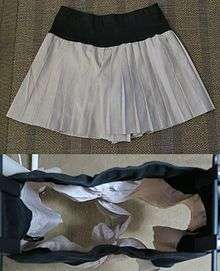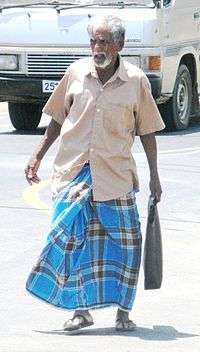Skirt
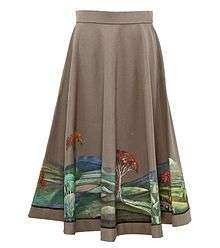
.webm.jpg)
A skirt is the lower part of a dress or gown, covering the person from the waist downwards, or a separate outer garment serving this purpose.[1]
The hemline of skirts can vary from micro to floor-length and can vary according to cultural conceptions of modesty and aesthetics as well as the wearer's personal taste, which can be influenced by such factors as fashion and social context. Most skirts are self-standing garments, but some skirt-looking panels may be part of another garment such as leggings, shorts, and swimsuits.
In the western world, skirts are more commonly worn by women; with some exceptions such as the izaar which is worn by Muslim cultures and the kilt which is a traditional men's garment in Scotland and Ireland. Some fashion designers, such as Jean Paul Gaultier, have shown men's skirts. Other cultures traditionally wear skirts.
At its simplest, a skirt can be a draped garment made out of a single piece of material (such as pareos), but most skirts are fitted to the body at the waist or hips and fuller below, with the fullness introduced by means of darts, gores, pleats, or panels. Modern skirts are usually made of light to mid-weight fabrics, such as denim, jersey, worsted, or poplin. Skirts of thin or clingy fabrics are often worn with slips to make the material of the skirt drape better and for modesty.
History
A straw-woven skirt dating to 3900 BC was discovered in Armenia at the Areni-1 cave complex.[2] Skirts have been worn by men and women from many cultures, such as the lungi, lehnga, kanga and sarong worn in South Asia and Southeast Asia, and the kilt worn in Scotland and Ireland.
The earliest known culture to have females wear clothing resembling miniskirts were the Duan Qun Miao (短裙苗), which literally meant "short skirt Miao" in Chinese. This was in reference to the short miniskirts "that barely cover the buttocks" worn by women of the tribe, and which were "probably shocking" to observers in medieval and early modern times.[3]
In the Middle Ages, some upper-class women wore skirts over three metres in diameter at the bottom. At the other extreme, the miniskirts of the 1960s were minimal garments that may have barely covered the underwear when seated. Costume historians typically use the word "petticoat" to describe skirt-like garments of the 18th century or earlier.
19th century
During the 19th century, the cut of women's dresses in western culture varied more widely than in any other century. Waistlines started just below the bust (the Empire silhouette) and gradually sank to the natural waist. Skirts started fairly narrow and increased dramatically to the hoopskirt and crinoline-supported styles of the 1860s; then fullness was draped and drawn to the back by means of bustles. In the 1890s the rainy daisy skirt was introduced for walking or sportswear. It had a significantly shorter hemline measuring as much as six inches off the ground and would eventually influence the wider introduction of shorter hemlines in the early 20th century.[4]
20th and 21st centuries
Beginning around 1915, hemlines for daytime dresses left the floor for good. For the next fifty years fashionable skirts became short (1920s), then long (1930s), then shorter (the War Years with their restrictions on fabric), then long (the "New Look"), then shortest of all from 1967 to 1970, when skirts became as short as possible while avoiding exposure of underwear, which was considered taboo.
Since the 1970s and the rise of pants/trousers for women as an option for all but the most formal of occasions, no one skirt length has dominated fashion for long, with short and ankle-length styles often appearing side-by-side in fashion magazines and catalogs.
Basic types
- A-line skirt, a skirt with a slight flare, roughly in the shape of a capital letter A
- Bell-shaped skirt, flared noticeably from the waist but then, unlike a church bell, cylindrical for much of its length
- Circle skirt, a skirt cut in sections to make one or more circles with a hole for the waist, so the skirt is very full but hangs smoothly from the waist without darts, pleats, or gathers
- Culottes, a form of divided skirt constructed like a pair of shorts, but hanging like a skirt.[5]
- Full skirt, a skirt with fullness gathered into the waistband
- Pleated skirt, a skirt with fullness reduced to fit the waist by means of regular pleats ('plaits') or folds, which can be stitched flat to hip-level or free-hanging
- Short skirt, a skirt with hemline above the knee
- Straight skirt or Pencil skirt, a tailored skirt hanging straight from the hips and fitted from the waist to the hips by means of darts or a yoke; may have a vent or kick-pleat set in the hem for ease of walking
- Wrap or wraparound skirt, a skirt that wraps around the waist with an overlap of material
Fads and fashions
- Ballerina skirt, a mid-calf full skirt popular in the 1950s.
- Broomstick skirt, a light-weight ankle-length skirt with many crumpled pleats formed by compressing and twisting the garment while wet, such as around a broomstick. (1980s and on)
- Bubble dress/skirt, a voluminous skirt whose hem is tucked back under to create a “bubble effect” at the bottom.
- Cargo skirt, a plain utilitarian skirt with belt loops and numerous large pockets, based on the military style of Cargo pants and popularised in the 1990s.
- Crinoline, a very full skirt supported by hoops or multiple petticoats, popular at various times from the mid 19th century onwards.
- Dirndl skirt, a skirt in the German-Austrian dirndl style, made of a straight length of fabric gathered at the waist
- Denim skirt (or jeans skirt), a skirt made of denim, often designed like 5-pocket jeans, but found in a large variety of styles.
- Hobble skirt, a long and tight skirt with a hem narrow enough to significantly impede the wearer's stride
- Kilt-skirt, a wrap-around skirt with overlapping aprons in front and pleated around the back. Though traditionally designed as women's wear, it is fashioned to mimic the general appearance of a man's kilt.
- Leather skirt, a skirt made of leather
- Lehenga (also Ghagra; Garara ), a long, pleated skirt, often embroidered, worn mostly as the bottom part of the Gagra choli in North India and Pakistan.[6]
- Micromini, an extremely short miniskirt.
- Mini-crini, a mini-length version of the crinoline, designed by Vivienne Westwood in the mid 1980s.[7]
- Poodle skirt, a circle or near-circle skirt with an appliqued poodle or other decoration (1950s)
- Puffball skirt (also called "puff" or "pouf"), a bouffant skirt caught in at the hem to create a puffed silhouette. Popular in the mid-late 1980s when it was inspired by Westwood's "mini-crini".[8]
- Rah-rah skirt, a short, tiered, and often colourful skirt fashionable in the early-mid-1980s.
- Sarong, a square or rectangle of fabric wrapped around the body and tied on one hip to create a skirt that can be worn by both sexes
- Scooter skirt or skort (variant), a skirt that has an attached pair of shorts underneath for modesty. Alternatively, but with similar effect, a pair of shorts incorporating a skirt-like flap across the front of the body.
- Skater skirt, a short, high-waisted circle skirt with a hemline above the knee, often made of lighter materials to give the flowing effect that mimics the skirts of figure skaters.
- T-skirt, made from a tee-shirt, the T-skirt is generally modified to result in a pencil skirt, with invisible zippers, full length two-way separating side zippers, as well as artful fabric overlays and yokes.
- Tiered skirt, made of several horizontal layers, each wider than the one above, and divided by stitching. Layers may look identical in solid-colored garments, or may differ when made of printed fabrics.
- Prairie skirt (variant), a flared skirt with one or more flounces or tiers (1970s and on)
- Trouser skirt or cullotte, a straight skirt with the part above the hips tailored like men's trousers, with belt loops, pockets, and fly front.
Lengths
-

Long skirt, floor or near-floor length.
-

Ankle-length skirt or 'maxi,' a term introduced in the late 1960s
-

Mid-calf length or 'midi,' a term introduced in the 1970s.
-
.png)
Microskirt, an extremely short miniskirt.
-
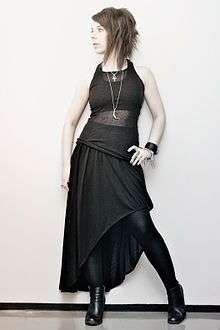
High-low/hi-lo skirt, a skirt with an asymmetrical hemline.
Male wear

There are a number of garments marketed to men which fall under the category of "skirt" or "dress". These go by a variety of names and form part of the traditional dress for men from various cultures. Usage varies – the dhoti is part of everyday dress on the Indian subcontinent while the kilt is more usually restricted to occasional wear and the foustanella is used almost exclusively as costume. Robes, which are a type of dress for men, have existed in many cultures, including the Japanese kimono, the Chinese cheongsam, the Arabic thobe, and the African Senegalese kaftan. Robes are also used in some religious orders, such as the cassock in Christianity and various robes and cloaks that may be used in pagan rituals. Examples of men's skirts and skirt-like garments from various cultures include:
- The fustanella is worn by men in Greece and other parts of the Balkans. By the mid-20th Century, it was relegated to ceremonial use and as period or traditional costume.
- The gho is a knee-length robe worn by men in Bhutan. They are required to wear it every day as part of national dress in government offices, in schools and on formal occasions.[9]
- The kilt is a skirt of Gaelic and Celtic history, part of the Scottish national dress in particular, and is worn formally and to a lesser extent informally. Irish and Welsh kilts also exist but are not so much a part of national identity.
- The sarong is a piece of cloth that may be wrapped around the waist to form a skirt-like garment. Sarongs exist in various cultures under various names, including the pareo and lavalava of the Hawaiian islands and Polynesia (Samoa, Tonga, Tahiti, and Fiji), the Indian dhoti and lungi, and the South Indian and Maldivian mundu.
Aside from the wearing of kilts, in the Western world skirts, dresses, and similar garments are commonly considered primarily women's clothing – which, historically, was not always the case.[10]
Gallery
- Basic types
-
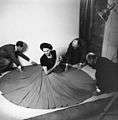
Circle
-

Full (in motion)
-

Pleated
- Fads and fashions
- World culture
References
- ↑ "Skirt". Oxford English Dictionary (3rd ed.). Oxford University Press. September 2005. (Subscription or UK public library membership required.)
- ↑ "5,900-year-old women's skirt discovered in Armenian cave". News Armenia. September 13, 2011. Retrieved September 14, 2011.
- ↑ Harrell, Stevan (1995). Cultural Encounters on China's Ethnic Frontiers. University of Washington Press. pp. 98 & 103. ISBN 0-295-97528-8.
- ↑ Hill, Daniel Delis (2007). As seen in Vogue : a century of American fashion in advertising (1. pbk. print. ed.). Lubbock, Tex.: Texas Tech University Press. pp. 23–25. ISBN 978-0-89672-616-1.
- ↑ Yarwood, Doreen (2011). Illustrated encyclopedia of world costume. Mineola, N.Y.: Dover Publications, Inc. p. 376. ISBN 9780486433806.
- ↑ "Social Science a Textbook in History for Class IX as per New Syllabus". google.co.in.
- ↑ Staff writer. "Vivienne Westwood designs". Victoria and Albert Museum. Retrieved 5 June 2015.
- ↑ Evans, Caroline (2004). "Cultural Capital 1976–2000". In Breward, Christopher; Ehrman, Edwina; Evans, Caroline. The London look : fashion from street to catwalk. New Haven: Yale University Press / Museum of London. p. 149. ISBN 9780300103991.
- ↑ "Gho & Kira: The National Dress". Bhutan's Culture. RAOnline. Retrieved 31 July 2010.
- ↑ A closer look at men in skirts, CNN, November 3, 2003. Retrieved March 17, 2008.
- Brockmamn, Helen L.: The Theory of Fashion Design, Wiley, 1965.
- Picken, Mary Brooks: The Fashion Dictionary, Funk and Wagnalls, 1957. (1973 edition ISBN 0-308-10052-2)
- Tozer, Jane, and Sarah Levitt: Fabric of Society: A Century of People and Their Clothes 1770–1870, Laura Ashley Ltd., 1983; ISBN 0-9508913-0-4
External links
| Look up skirt in Wiktionary, the free dictionary. |
| Wikimedia Commons has media related to Skirts. |
| Wikimedia Commons has media related to Miniskirts. |
- ApparelSeach glossary of textile and apparel terms
- An international dress size converter
- New South Korean Law Might Make Miniskirts Illegal
- France Revokes 214-Year-Old Law That Made It Illegal For Women To Wear Pants


